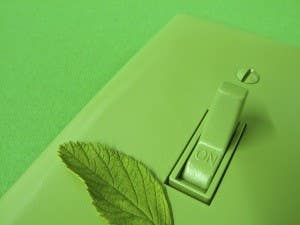Compact Fluorescent Light Bulbs and the Environment
- What compact fluorescent tubes are and how they work.
- Why they are so much more beneficial to the environment when compared to incandescent bulbs.
- How to dispose of the bulbs safely.
Domestic fluorescent lights are generally understood to be the eco-friendly option in the home, but what is it about them that makes them so good for the environment and how much better are they? The light bulbs we're referring to are generally known as compact fluorescent lights or CFLs and we're going to give you a brief insight into why these light bulbs are considered the best option in the home. In 2012, 40W incandescent bulbs began to be phased out in the EU, following the existing ban on 100W and 60W bulbs, which means no new bulbs will be manufactured or imported for sale. No incandescent bulbs are harder to come by, CFLs will be seen in many more homes.
What are CFLs?

A CFL is simply a miniature version of the fluorescent tube lighting you'll see in office spaces, schools and public buildings. They work in exactly the same way as larger T5 tubes but are much smaller and are moulded in a bent parallel rod shape or in a spiral.
How do they work?
The fluorescent tubes are filled with conductive gas which contains mercury, argon, xenon, krypton or neon. A ballast creates an electrical current from a wall outlet through the gas which then gives off ultraviolet light. This light comes into contact with a phosphorescent coating on the inside of the tube which glows upon contact and creates the light we see.
Why are they environmentally friendly?
CFLS use a lot less energy than the traditional incandescent bulbs. An incandescent bulb generates light by heating a metal filament which means that a lot of energy is lost as heat energy (you'll notice that a CFL is considerably cooler than an incandescent bulb). A CFL will give the same amount of light as an incandescent bulb using one-fifth to one-third of the electric power it uses, and will last eight to 15 times longer. So although the initial price of a CFL is more than a traditional incandescent bulb, the former can save over five times its purchase price in electricity costs over its lifetime.
CFLs are very versatile bulbs and can be used with dimmer switches and tri-lamps (lamps which product three different levels of light) and CFLs can even be used outdoors in enclosed fixtures.

What about disposal?
CFLs do contain mercury which can complicate disposal, but as long as you're clued up on the correct way to bin CFLs then it doesn't need to be a big problem, and the overall saving in electricity still makes them the eco-friendly option. There are lots of recycling points all over the UK where you can recycle your CFLs safely. Take a look here to find the nearest one to you. If you break a CFL (which is harder to do than an incandescent bulb as CFLs are far more robust) then your number one priority is to minimise unnecessary mercury exposure. It's best to immediate clean and ventilate the room for about 15 minutes.
Households are not banned from putting their WEEE waste in their general bin but the environment agency has created a network of collection points for this kind of waste to make recycling easier. You now have the right to:
- Ask the retailer to take the product back
- Take the old appliance to a local recycling site
- Arrange for the local authority to collect the equipment (some for free, others charge)
A lot of retailers now accept old low energy light bulbs including Sainsbury's, Robert Dyas and Homebase, and lots of local businesses will be willing to take back electrical equipment. Luckily there are various charities set up to help you locate collection points and give you advice on how to get rid of your bulbs. Recycle-more.co.uk has a lot of information and Recolight are a not-for-profit organisation with loads of information on recycling bulbs and a handy map which shows local recycling points near your address.
Various charities and the environment agency are working hard to make recycling fluorescent bulbs in the UK easier for homeowners and consumers. A lot of people aren't necessarily aware of how they should be disposing of their CFLs, but it's important to get clued up on energy saving bulbs to do your bit for the environment and make sure your home is safe.

CFL's are without doubt a step towards sustainability within the home, so if you haven't made the switch yet then it'd be a good idea to look into it. These light bulbs are designed to be compatible with fittings previously designed for incandescent bulbs so will fit into traditional style fittings with ease. With a CFL bulb you'll not only be doing your bit for the planet, but you'll also save heaps of money, so why not consider making the switch and reaping the inherent benefits!
Published 2015/02/16
